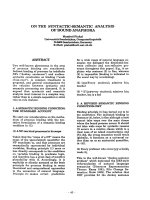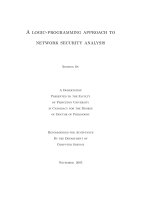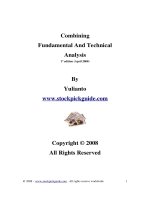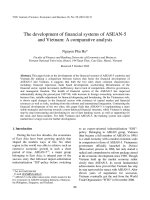Referent Group Benefit-Cost Analysis potx
Bạn đang xem bản rút gọn của tài liệu. Xem và tải ngay bản đầy đủ của tài liệu tại đây (194.5 KB, 18 trang )
© Harry Campbell & Richard Brown
School of Economics
The University of Queensland
BENEFIT-COST ANALYSIS
BENEFIT-COST ANALYSIS
Financial and Economic
Financial and Economic
Appraisal using Spreadsheets
Appraisal using Spreadsheets
Ch. 6: Referent Group Benefit-Cost Analysis
Referent Group Net Benefits
What is the “referent group”?
- it is the group whose net benefits are relevant to the
decision-maker who commissioned the SBCA.
What will the referent group normally consist of?
- all residents of a region, state or country
- all members of a social group, for example, pensioners,
native peoples etc.
If only referent group benefits are relevant, why bother to calculate
efficiency net benefit?
•
Efficiency net benefit is the aggregate net benefit for the
project as a whole, using opportunity cost as efficiency prices.
•
This relationship provides a check on the consistency of the
BCA as a whole.
•
The sum of referent group and non-referent group net benefits
must equal the efficiency net benefit.
Recall Figure 1.3:
C
(=referent group
net benefits not
captured by
market prices)
B
(= non-referent group
net benefits)
A
(= referent
group net
benefits)
D
= non-ref. group non-market
net benefits
(we add segment D)
Why do we need BCA to identify referent group net benefits?
•
A project evaluation will only capture benefits and costs
which are fully measured by market prices. It fails to capture
various public interest aspects of a project. For example:
- employment benefits
- indirect tax revenue changes
- pollution costs etc.
Four-way Classification of Net Benefits
Net benefits accruing to:
Referent Non-referent
Group Group
Captured A B
by market prices
Not captured by C D
market prices
Figure 6.1: Classification of Net Benefits
Graphical Representation of Classification
In specific cases some of the cells in the four-way classification
can be empty.
For example, in figure 1.3 cell D was empty (and was omitted from
the diagram) because there were no non-referent group net benefits
that were not captured by the market.
•
Such net benefits might have resulted from global pollution
or from market imperfections in the foreign country.
In general, what cells in the four-way classification could be empty?
1. If C+D is empty, then the project analysis coincides with the
efficiency analysis.
2. If A+C is empty, then the project has no relevance for the
Referent Group.
3. If B+D is empty, the non-referent group is not affected by the
project.
4. If A+B is empty, the project does not involve any inputs or
outputs traded in the market.
How do we identify the various categories of disaggregated
Referent Group net benefits?
1. Follow the financial flows:
- division of project profits between referent and non-referent
group members;
- identify direct and indirect tax flows, e.g. business income
tax, sales tax, tariffs etc.
2. Learn from the shadow-prices:
- where there is a shadow-price, the project analysis has
failed to pick up an efficiency net benefit that must be
assigned to either the referent or non-referent group.
Figure 6.1: Using Shadow-prices to Identify Referent Group
Benefits or Costs
Input Output
Market Price Benefit to the Cost to public
Greater than Owner of the or Government
Shadow-price input eg. eg. loss of
unemployed tariff revenue,
labour cost of pollution
generated by use
Market Price Cost to alternative Benefit to
Less than user of the input general public
Shadow-price eg. monopoly or eg. vaccination
monopsony
employer
To Recap: How do we approach BCA?
1. Do the project analysis first (A+B) because of availability of data.
2. Do the private analysis, i.e. identify the subset of A+B that affects
private equity-holders.
3. Do the efficiency analysis (A+B+C+D) using shadow-prices and
non-market valuations where appropriate.
4. Calculate aggregate Referent Group net benefits:
(A+B+C+D) - (B+D) = (A+C)
5. Calculate disaggregated RG net benefits
(A
1
+ A
2
+ A
3
+ C
1
+
C
2
+
C
3
) and do a check.
Simple Example
NFG Case Study (cont.)
NFG Case Study (cont.)
Distribution of Project Net Benefits
Distribution of Efficiency Benefits
Other Important Issues
•
Weighting of net benefits to different stakeholders
•
Treatment of risk and uncertainty
•
Choice of discount rate
•
Valuation (efficiency prices) of non-market costs and
benefits









